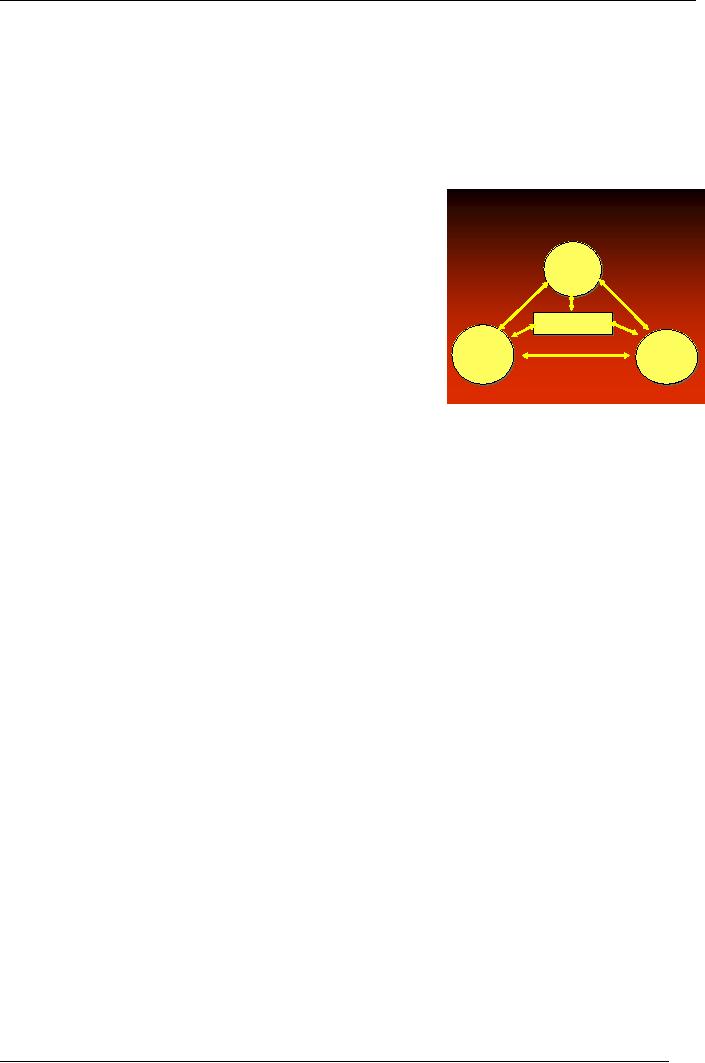 |

Human
Resource Management
(MGT501)
VU
Lesson
25
PERFORMANCE
After
studying this chapter, students should be
able to understand the
following:
M.
Internal
Barriers to Career Advancement
N.
Successful
Career-Management Practices
O.
Individual
and Organizational Perspectives on Career
Planning
P.
Performance
LESSON
OVERVIEW
In
this lecture, we will discuss the
barriers to effective career development.
Next, we will learn about
some
basic
concepts of performance. We will
also discuss an important
function of effective management
is
accurate
measurement of employee performance. This
chapter discusses the foundation,
design, and
implementation
of performance measurement systems. In
addition, it describes the principles of
effective
performance
management.
M.
Internal Barriers to Career
Advancement
There
can be following types of barrier
that can influence the effectiveness of
the career advancement.
�
Lack of time,
budgets, and resources for
employees to plan their careers
and to undertake
training
and development.
�
Rigid
job specifications, lack of
leadership support for
career management, and a
short-term
focus.
�
Lack
of career opportunities and
pathways within the organization for
employees
N.
Successful Career-Management
Practices
Following
steps can be helpful towards
successful career management
practices in the organizations.
�
Placing
clear expectations on
employees.
�
Giving
employees the opportunity for
transfer.
�
Providing
a clear succession plan
�
Encouraging
performance through rewards
and recognition.
�
Encouraging
employees to continually assess
their skills and career
direction.
�
Giving
employees the time and resources they
need to consider short- and
long-term career
goals.
O.
Individual and Organizational
Perspectives on Career
Planning:
Effective
career planning, that is
ensured with monitoring to
record the failures and
successes, provides
continuous
chances and opportunities to
employees towards career development
that will definitely
produce
more
committed and effective workforce.
P.
Performance:
Why
Do We Care?
Performance
can be defined as efforts along
with the ability to
put
Ability
efforts
supported with the organizational policies in
order to
achieve
certain objectives.
PERFORMANCE
Performance
is the function of:
Opportunity
Motivation
a)
Ability:
The
basic skills possessed by the
individual that
are
required to give certain performance
enhances the level
Performance
=
f
(Ability, Motivation,
Opportunity)
of
performance.
111

Human
Resource Management
(MGT501)
VU
b)
Motivation:
Activities
in HRM concerned with helping
employees exert high energy
levels and to
get
performance in desirable
direction.
c)
Opportunity:
Circumstances
under which performance is made they
can be ideal or vice
versa.
I.
Determinants of Job
Performance
There
are three basic determinants
of the job they are as
following:
1)
Willingness
to perform: If
employee is performing tasks
and responsibilities in the organization
with
willingness level of the performance will
be high and
Determinants
of Job
will
be up to the standards.
2)
Capacity
to Perform: If the
basic qualifications abilities
Performance
and
skills required performing specific
tasks are
possessed
by the employees the level of performance
will
Willingness
to
perform
be
in accordance with the set
standards and vice
versa.
3)
Opportunity
to Perform: Favorable
circumstances and
opportunities
to perform the challenging tasks
which are
Job
performance
more
contributory towards
achievement of the
Capacity
to
Opportunity
organization's
mission and objective can be
reasons to
perform
to
perform
have
more effective performance from
employees.
II.
Sample Core Performance
Indicators
These
indicators are used to measure
Organizational Effectiveness. Researchers see primary
management
tasks
as control, innovation, and efficiency.
Control means dominating the external
environment, attracting
resources,
and using political
processes. Innovation entails
developing skills to discover
new products and
processes
and designing adaptable
structures and cultures.
Efficiency involves developing modern
plants for
rapid,
low-cost production, fast distribution,
and high
productivity.
a.
The External Resource Approach:
Control
Using
the external resource approach, managers
evaluate a firm's ability to
manage and control the
external
environment.
Indicators include stock price,
profitability, return on investment, and
the quality of a
company's
products. An important factor is
management's ability to perceive
and respond to
environmental
change.
Stakeholders value aggressiveness
and an entrepreneurial spirit.
b.
The Internal Systems Approach:
Innovation
Using
the internal systems approach,
managers evaluate organizational
effectiveness. Structure and
culture
should
foster flexibility and rapid
response to market changes.
Flexibility fosters innovation.
Innovation is
measured
by the time needed for decision
making, production, and
coordinating activities.
c.
The Technical Approach:
Efficiency
The
technical approach is used to
evaluate efficiency. Effectiveness is
measured by productivity
and
efficiency
(ratio of outputs to inputs).
Productivity gains include increased
production or cost reduction.
Productivity
is measured at all stages of
production. Service companies could
measure sales per employee
or
the
ratio of goods sold to goods
returned. Employee motivation is an important
factor in productivity
and
efficiency.
d.
Measuring Effectiveness: Organizational
Goals
Organizational
effectiveness is evaluated by both
official and operative goals.
Official goals are the
formal
mission
of an organization. Operative goals are
specific long-term and short-term
goals that direct
tasks.
Managers
use operative goals to measure
effectiveness. To measure control,
managers examine market
share
and
costs; to measure innovation, they review
decision-making time. To measure efficiency, they
use
benchmarking
to compare the company to competitors. A
company may be effective in one
area and
ineffective
in another. Operative goals must be
consistent with official
goals.
III.
Why
is performance measured?
�
Enhances
motivation & productivity
�
Assists
in validation studies
�
Detects
problems
112

Human
Resource Management
(MGT501)
VU
�
Helps
evaluate change
efforts
�
Provides
basis for making
decisions
�
Differentiates
employees in job-related areas
�
Helps
ensure legal
compliance
IV.
Performance Management
A
process that significantly affects
organizational success by having managers
and employees work
together
to
set expectations, review results,
and reward performance.
Performance management is a means of
getting
better
results... by understanding and
managing performance within an
agreed framework of planned goals,
standards
and competence requirements. It is a
process to establish a shared
understanding about what is to
be
achieved, and an approach to
managing and developing people so
that it will be achieved.
The Goal of
measuring
performance is to improve the
effectiveness & efficiency of the organization by aligning
the
employee's
work behaviors & results
with the organization's goals improving
the employee's work
behaviors
& results. It is on-going, integrative
process.
Key
Terms
Performance:
Performance
can be defined as efforts along
with the ability to put
efforts supported with
the
organizational policies in order to
achieve certain
objectives.
Motivation:
Activities
in HRM concerned with helping
employees exert high energy
levels and to get
performance
in desirable direction.
Performance
Management: A
process that significantly affects
organizational success by having
managers
and
employees work together to set
expectations, review results, and
reward performance.
113
Table of Contents:
- INTRODUCTION TO HRM:Growing Importance of HRM, Road Map of the Course
- ESSENTIALS OF MANAGEMENT:Concepts and Essential of Management, Manager’s Roles
- ORGANIZATION AND COMPONENTS OF ORGANIZATION:Open versus Closed Systems, The Hawthorne Studies
- PEOPLE AND THEIR BEHAVIOR:Why to work in organizations?, The Goals of Organizational Behavior
- INDIVIDUAL VS. GROUP BEHAVIOR:What Are Roles?, Problem solving Team
- PERSONNEL MANAGEMENT TO HUMAN RESOURCE MANAGEMENT:Records and Administration, Competitive Advantage
- HRM IN A CHANGING ENVIRONMENT:Productivity, New Trends at Work Place
- How organization Cultivate a Diverse Workforce, STEPS TOWARD MANAGEMENT OF DIVERSITY
- FUNCTIONS AND ENVIRONMENT OF HRM:Compensation and Benefits, Safety And Health, Interrelationships of HRM Functions
- LINE AND STAFF ASPECTS OF HRM:Authority, Line versus Staff Authority, Staff Manager
- LEGAL CONTEXT OF HR DECISIONS:Doing the Right Thing, Affirmative Action, Unintended Consequences
- HUMAN RESOURCE PLANNING (HRP):Benefits of HR Planning, Forecasting Human Resource Availability
- STRATEGIC PLANNING AND HRIS:HR’s Strategic Role, Human Resource Information System, Common HRIS Functions
- JOB ANALYSIS:Purposes of the job Analysis, Questions Job Analysis Should Answer
- JOB ANALYSIS:Methods of Collecting Job Analysis Information, Observation, Source of Data
- JOB ANALYSIS (CONTD.):SURPLUS OF EMPLOYEES FORECASTED, Diversity through Recruiting Efforts
- SOURCES OF RECRUITMENT:ALTERNATIVES TO RECRUITMENT, Quantity of the Applicants, Quality of the Applicants
- SELECTION:Initial Screening, Advantages of Successful Screening
- SELECTION TESTS:Characteristics of Properly Designed Selection Tests, Guidelines for Conducting an Interview
- SELECTION PROCESS… CONTD:Background Investigations, Physical Exam, Selecting Managers
- SOCIALIZATION:Compensation and Benefits, Team Membership, Stages in socialization Process, Training and Development Trends
- TRAINING AND DEVELOPMENT:Learning, Phases of Training, Why Transfer of Training Fails
- MAXIMIZING LEARNING:Following up on Training, Repetition, Feedback, Purposes of T & D
- CAREER MANAGEMENT:Individual career planning, Career Planning and Development Methods
- PERFORMANCE:Determinants of Job Performance, Why is performance measured?, Performance Management
- PERFORMANCE APPRAISAL:What to Evaluate, The Appraisal Interview, PROBLEMS IN PERFORMANCE APPRAISAL
- JOB EVALUATION AND PRICING:THE APPRAISAL PERIOD, Ranking method,
- COMPENSATION SYSTEM:Pay, Job Pricing, Compensation: An Overview, Compensation Surveys
- BENEFITS:Total Compensation, Discretionary Benefits (Voluntary), Workplace Flexibility
- ROLE OF MONEY IN PERFORMANCE OF EMPLOYEES:Types of Pay-for-Performance Plans, Empower Employees
- MOTIVATION:The Motivation Process, Motivational Theories, Challenges of motivating employees
- OCCUPATION, HEALTH & SAFETY:Physical Conditions, Accident Investigation, Smoking in The work place
- STRESS MANAGEMENT:Symptoms of Stress, Managing Stress,
- COMMUNICATION IN ORGANIZATION:Burnout, Social Support at Work & Home, Communication in organization, Meetings
- TRADE UNIONS:Collective Bargaining, The HRM Department in a Nonunion Setting, Phases of Labor Relations
- CONFLICT AND NEGOTIATION:Transitions in Conflict Thought, Individual Conflict Management Styles
- POWER AND POLITICS:Sources of Power, Advantages and Disadvantages of PowerPower and Politics in Context
- EMPLOYEE RIGHTS AND DISCIPLINE:Contractual Rights, Management Rights, Disciplining Employees,
- DISCIPLINE (CONT...):Factors to Consider when Disciplining, Disciplinary Guidelines, Employee Separations
- LEADERSHIP:The Leader’s Behavior, Situational Theories of Leadership, Becoming a Leader
- REVISION (LESSON 12-21):Plans, Job Specification, Human resource planning, Selection Process, Corporate Culture
- REVISION (LESSON 22-26):Training, Case Study Method, Training, Performance
- REVISION (LESSON 27-35):Classification Method, Compensation, Empowerment, Mediation
- INTERNATIONAL DIMENSIONS OF HRM:Global Corporation, Type of staff members, Approaches to Global Staffing
- CONCLUSION & REVIEW:Strategies for Gaining Competitive Advantage, High-performance Work System